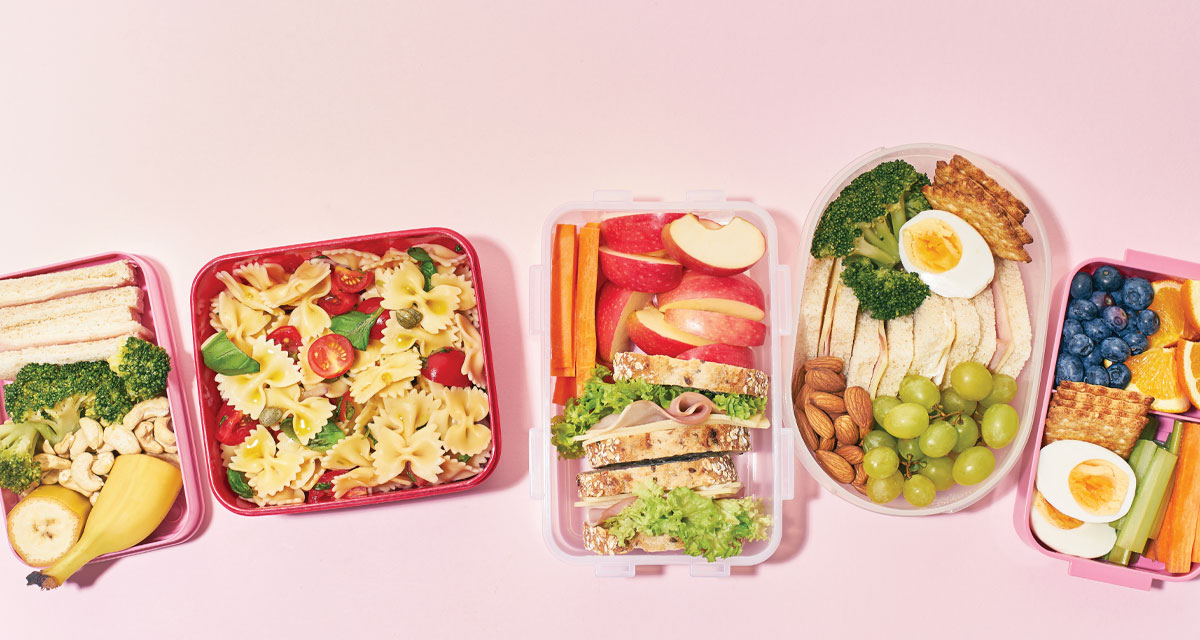by KATIE MAXEY, MS, RD, IBCLC
School supplies are filling the shelves, kids are anxiously awaiting to hear if they will be in class with their friends and back to school shopping is in full force. You pick out the bookbag, the notebooks and the #2 pencils. Then, it’s time for the lunch box. Will your child eat what you pack? Would they rather eat from the school cafeteria? You begin to dread the next 10 months of finding lunch box ideas that your child will eat and will not become repetitive. The good news is that your lunch box menu is about to get simplified, and your child is going to help you come up with his or her menu for each day! Get your pen and paper ready for YOUR back-to-school list. Because your back-to-school lunch box menu planning is about to start…now.
Most people think of a sandwich and chips for lunch. Maybe throw in some gummies and grapes and call it a day. Moving forward, think of the lunch box as food group sections. Could it be a sandwich? Sure, but there are so many more options you and your child can come up with that include the same food groups that a sandwich includes which is a grain and a protein. Begin to categorize lunch box items into the food groups listed below. You and your children can go through each food group and create a go-to list that they would like to have from that food group! Then you can pair it together to make a balanced lunch box that includes variety throughout the year.
Protein: Protein is important to include in each lunch box. It’s the food group that is going to help satisfy your child and keep hunger at bay until the after-school snack. Obvious protein sources that many think of packing in school lunches are sandwich deli meat, peanut butter or nut butter alternatives. But, did you realize that you can also pack dairy products as protein sources? Dairy food such as yogurt and cheese can help fill your child’s stomach and provide essential nutrients. Other protein sources for lunch boxes include chicken nuggets, spaghetti meat sauce, boiled eggs, edamame, beef jerky, taco meat, flavored hummus, grilled chicken pieces and leftover cheeseburgers from dinner the night before. Use a thermos to keep certain proteins warm.
Grains: Grains are the easiest food group to pack in lunches. If you walk through the cafeteria and notice what has been packed in lunch boxes, you’ll notice this food group the most. There’s a lot of shelf stable options for grains that make it into kid’s lunch boxes. Be wise about including food from each food group instead of having most of the lunch box consisting of packaged grains. Grains are important, especially if they are high in fiber, to help with feeling satisfied and being the source of quick energy to help your child with the rest of the school day. But, they can provide excess calories that are not needed and can cause children to not eat enough of other food groups. Grains often seen in lunch boxes include bread products, packaged snacks and chips. Other grain sources for lunch boxes include pita bread, high fiber crackers, pasta, rice, mini bagels, tortilla shells, spaghetti noodles and high fiber dry cereal. There are so many options to help with variety!
Vegetables: When we think of vegetables, we often assume our children will not like them. But, if we don’t offer them, we won’t know! Being around other children that are eating vegetables often helps children try new foods and learn to like them. Raw vegetables are popular and a great way to include a vegetable in the lunch box! Ideas include raw carrots, celery, broccoli, cauliflower, grape tomatoes, sliced cucumbers, side salads and vinegar-based cucumber salad. You can include vegetables as part of a main dish as well, such as doing a stir-fry with chicken and noodles that includes vegetables kept warm in a thermos.
Fruits: Most children seem to like fruit, so this is an easy one to include! Fresh fruit tends to be the go-to, but you can also include canned fruit, dried fruit, applesauce pouches and frozen fruit. You could try freezing grapes, so they are still a little crunchy by lunch time (and they keep your lunch box cold without the need for an ice pack). You could also pack the ingredients for your child to make a yogurt parfait for lunch which will include fresh fruit, yogurt (protein) and granola (grain). You can be creative with your fruits to help spice it up throughout the year!
Once you and your child list food options from each food group, get creative together and come up with different combinations that make sense for your child and for your budget! Doing this a few times a year and refreshing the list will help you continue to add new ideas. Your children may see others packing food that they want to include on their list. Keep your list handy to add new ideas!
Fun lunch box combo ideas:
- Beef soft taco with shredded cheese on top, raw broccoli with ranch dip and sliced strawberries.
- Bites of lunch box sushi: Roll up deli meat and cheese in a high-fiber tortilla or flat-bread, cut into sushi slices. Serve it with raw carrots and cut watermelon.
- Round apple slices topped with peanut butter, dry high-fiber trail mix and sliced cucumbers.
- Pasta salad that includes high-fiber pasta, raw vegetables, diced chicken and dressing. Serve with sliced peaches.
- Homemade bagel bite pizzas using mini-bagels, pizza sauce, mozzarella cheese and diced pepperoni. Serve with raw cauliflower and ranch with a side of grapes.
- Pita pocket sandwich with chicken salad served with honey carrots and an applesauce pouch.
Great creative and have fun! Happy packing!























